Barrett M107A1 20″ Semi-Auto .50 BMG Rifle, Gray Cerakote – 18068 For Sale
$13,510.99
The Barrett M107A1 20″ Semi-Auto .50 BMG Rifle in Gray Cerakote is a cutting-edge firearm developed from over 35 years of innovation and feedback from elite military users. While maintaining the iconic design and reliability of its predecessors, this rifle introduces advanced enhancements, achieving a 4-pound weight reduction with components that are lighter and stronger. Designed for high-stakes environments, it is optimized for use with a sound suppressor, offering essential signature reduction. Key features include a lightweight QD Titanium Bipod for stability, a suppressor-ready muzzle brake for recoil reduction, and backup iron sights for versatile aiming. The Gray Cerakote finish adds durability and style, making the M107A1 an exemplary choice for those demanding modern excellence in firearms technology.
What is the difference between M107A1 and M82A1?
The primary differences between the Barrett M107A1 and the M82A1 sniper rifles include the following:
1. **Weight Reduction**: The M107A1 is engineered to be lighter than the M82A1, thanks to the use of advanced materials and a redesigned muzzle brake.
2. **Suppressor Compatibility**: The M107A1 is designed to accommodate a suppressor, increasing its versatility and tactical applications. The M82A1 lacks this specific design feature.
3. **Lower Recoil**: The M107A1 features improvements to its recoil reduction systems, making it more comfortable and efficient to shoot over extended periods.
4. **Materials and Design Enhancements**: The M107A1 incorporates modern materials and minor design tweaks to improve overall performance and reliability compared to the older M82A1 model.
These improvements make the M107A1 a more advanced and adaptable option compared to the original M82A1.
Can you legally own a Barrett 50 cal?
In the United States, it is generally legal to own a Barrett .50 caliber rifle, but the specific regulations can vary depending on state and local laws. Federally, these rifles are legal to purchase, own, and use, provided you meet the standard requirements for firearms ownership, such as passing a background check and being of legal age. However, some states and localities have their own restrictions or bans on owning .50 caliber rifles. It’s important to check the laws specific to your area to ensure compliance.
What is the range of the m107a1 sniper rifle?
The Barrett M107A1 sniper rifle has an effective range of approximately 1,800 meters (around 1,970 yards). However, its maximum range extends beyond 2,400 meters (about 2,625 yards) depending on conditions and specific ammunition used.
Are Barrett rifles worth the money?
The value of Barrett rifles can vary depending on individual needs and perspectives. Here are some factors to consider:
1. **Performance**: Barrett rifles are renowned for their high accuracy, long-range capabilities, and military-grade performance, which are significant factors for some users, particularly in professional or specialized contexts.
2. **Build Quality**: They are known for their durability and robust construction, which can be appealing for enthusiasts and professionals who need reliable equipment.
3. **Purpose**: If your intent is for long-range shooting, competitive shooting, or military/law enforcement use, Barrett rifles might be worth the investment due to their specialized design and capabilities.
4. **Cost**: Barrett rifles are expensive, often considered a premium purchase. For casual shooters or those with budget constraints, the cost might outweigh the benefits.
5. **Resale Value**: High-end firearms like Barrett rifles tend to retain their value well, which can be an important consideration for long-term investment.
Ultimately, whether or not a Barrett rifle is worth the money depends on how much you value its specific features and if those match your intended use case.
Is the 416 Barrett better than the 50 BMG?
The .416 Barrett and the .50 BMG (Browning Machine Gun) are both powerful rifle cartridges, each with its own strengths and ideal use cases. Whether one is “better” than the other depends on the context in which you’re comparing them:
1. **Ballistics**: The .416 Barrett generally has a flatter trajectory and can maintain higher velocities over long distances compared to the .50 BMG. This can make it more accurate at extreme long ranges.
2. **Range**: The .416 Barrett is often preferred for long-range precision shooting due to its higher ballistic coefficient, resulting in better performance against wind drift.
3. **Penetration and Power**: The .50 BMG is more powerful in terms of raw energy, making it more effective for applications requiring greater stopping power and penetration, such as military and anti-material roles.
4. **Ammunition Availability**: The .50 BMG is more widely produced and available, often resulting in more options and generally lower cost compared to the .416 Barrett.
5. **Use Case**: For civilian shooters involved in precision shooting competitions or extreme long-range shooting, the .416 Barrett might be preferred. However, for military or tactical uses that require heavy firepower, the .50 BMG is often favored.
In conclusion, neither round is universally “better” than the other; it depends on what you value in terms of range, power, availability, and specific application.
Is the M107 a sniper rifle?
Yes, the M107 is a sniper rifle. It is a variant of the Barrett .50 caliber sniper rifle, specifically designed for long-range shooting.
What states ban 50 cal rifles?
As of the most recent information, several states in the United States have restrictions or bans on .50 caliber rifles:
1. **California**: Bans the sale of all .50 BMG rifles under state law.
2. **Connecticut**: Imposes restrictions on certain .50 caliber rifles by classifying them as “assault weapons”.
3. **Maryland**: Has restrictions as part of its assault weapons ban, which includes certain .50 caliber rifles.
4. **Massachusetts**: Regulates .50 caliber rifles, treating them similarly to large-capacity firearms.
It’s important to verify the current status, as laws and regulations can change. Always check the latest local and state laws for the most accurate information.
What does BMG stand for in guns?
In the context of guns, BMG stands for “Browning Machine Gun.” It is often associated with the .50 BMG (Browning Machine Gun) cartridge, which was designed for use in the M2 Browning heavy machine gun.
Can you hunt deer with a Barrett 50 cal?
Hunting regulations vary by location, so it’s important to check local laws and regulations before hunting with any firearm. In general, a Barrett .50 cal is not typically recommended for deer hunting due to its large size, excessive power, and the potential for meat damage. It’s designed for long-range shooting and military purposes rather than hunting game like deer. Always prioritize using a firearm that is appropriate for the game you’re hunting and complies with local hunting laws.
What sniper did Chris Kyle use?
Chris Kyle primarily used the McMillan TAC-338 sniper rifle, chambered in .338 Lapua Magnum, during his service as a U.S. Navy SEAL sniper. He also used other rifles, such as the Mk 12 Special Purpose Rifle and the Barrett M82, but the McMillan TAC-338 is particularly noted for its use in some of his longest, most notable shots.
What sniper rifle is used by secret service?
The U.S. Secret Service does not publicly disclose specific details about all the equipment they use, including sniper rifles. However, they are known to use a range of standard and specialized firearms suited for their protective missions, which can include sniper rifles used by other U.S. law enforcement and military agencies, such as the Remington 700 or the Heckler & Koch HK417. For authoritative information, it’s best to refer to official statements or publicly available government resources.
What is the best sniper rifle in the world?
Determining the “best” sniper rifle can be subjective and depends on specific requirements such as range, accuracy, durability, and user’s preference. However, some of the most highly regarded sniper rifles in the world include:
1. **Accuracy International AWM (Arctic Warfare Magnum)** – Known for its long-range accuracy and powerful performance, particularly with the .338 Lapua Magnum round.
2. **Barrett M82/M107** – Famous for its long-range capability and use by military forces worldwide, especially with its .50 BMG round.
3. **CheyTac M200 Intervention** – Renowned for its extreme long-range performance, particularly in precision shooting and military sniping.
4. **Remington MSR (Modular Sniper Rifle)** – Known for its modularity and adaptability to various calibers.
Each of these rifles has its own unique features and suitability for different scenarios, making them top choices depending on the intended use.
What is the difference between 50 cal and 50bmg?
The terms “50 cal” and “.50 BMG” often refer to similar ammunition, but there is a distinction:
1. **.50 Cal**: This term generally refers to any cartridge with a bullet diameter of 0.50 inches (12.7 mm). It is a broad term and can refer to various types of ammunition, including the .50 BMG, but also other cartridges like the .50 Action Express (.50 AE) used in pistols.
2. **.50 BMG**: Stands for .50 Browning Machine Gun and is a specific cartridge developed in the early 20th century for use in the Browning M2 machine gun. It is a powerful round used primarily in heavy machine guns, sniper rifles, and long-range target shooting due to its significant power and range.
In summary, while “.50 cal” can refer to any 0.50-inch diameter bullet, “.50 BMG” specifies a particular and very powerful type of ammunition with a well-defined use case and specifications.
What is the difference between the Barrett M95 and M107?
The Barrett M95 and M107 are both precision rifles designed by Barrett Firearms, but they have some key differences:
1. **Design and Purpose**:
– **M95**: The Barrett M95 is a bolt-action sniper rifle. It’s known for its compact size and lighter weight compared to other large-caliber rifles, making it more portable and suitable for sniping missions where mobility is important.
– **M107**: The Barrett M107 is a semi-automatic anti-materiel rifle, often referred to as the M82 in earlier versions. It’s designed for longer-range and heavier firepower engagements, including disabling vehicles and other material targets.
2. **Action**:
– **M95**: Operates with a bolt-action mechanism, which requires manual operation of the bolt to load each round. This typically results in slower firing rates but can improve accuracy.
– **M107**: Uses a semi-automatic action, allowing for quicker follow-up shots without manual cycling of the bolt. This makes it more effective in suppressive roles and rapid engagement scenarios.
3. **Size and Weight**:
– **M95**: The M95 is designed to be more compact and lightweight for ease of transport and handling by individual snipers.
– **M107**: Is larger and heavier, reflecting its design to handle the recoil and firepower of semi-automatic shooting at long distances.
4. **Usage**:
– **M95**: More commonly used for precision sniping missions by military and law enforcement special forces that need a portable high-caliber option.
– **M107**: Often employed in roles that require rapid engagement capabilities, such as anti-materiel operations, thanks to its semi-automatic feature.
5. **Ammunition**:
– Both rifles typically chamber the .50 BMG (Browning Machine Gun) cartridge, which is effective for long-range and anti-materiel targets. However, the distinct action mechanisms can influence their handling and firing dynamics.
Each rifle has its own tactical advantages based on the requirements of the mission, with the M95 focusing on precision and portability, while the M107 offers rapid fire capability for larger scale and dynamic engagements.
What is the speed of the Barrett M107A1 bullet?
The Barrett M107A1 fires a .50 BMG (Browning Machine Gun) cartridge, and the bullet speed is approximately 2,800 to 2,900 feet per second (about 853 to 884 meters per second), depending on the type of ammunition used.
| Product Line | M107A1 |
|---|---|
| Action | Semi-Auto |
| Overall Length | 48" |
| Magazines Included | 1 (10 Round) |
Be the first to review “Barrett M107A1 20″ Semi-Auto .50 BMG Rifle, Gray Cerakote – 18068” Cancel reply
Related products
Barrett M107A1
Barrett Firearms M107 A1 .50 BMG Semi-Automatic Rifle, Gray Cerakote/Black Parkerized – 14552
Barrett M107A1
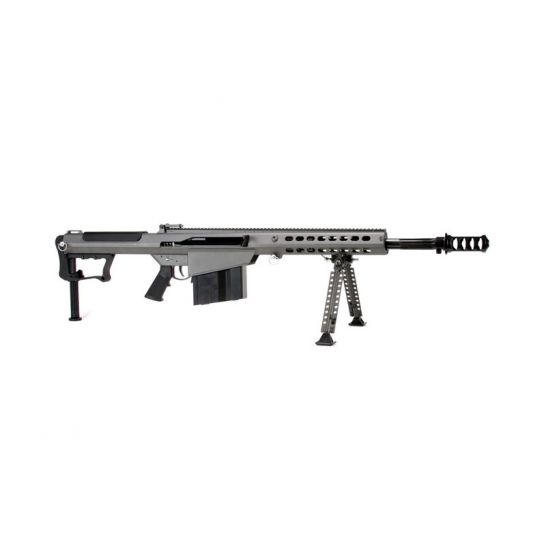
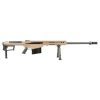
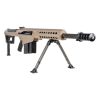
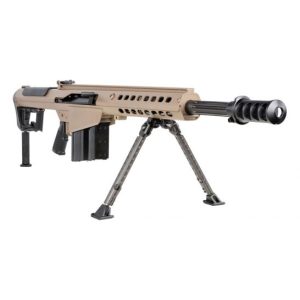
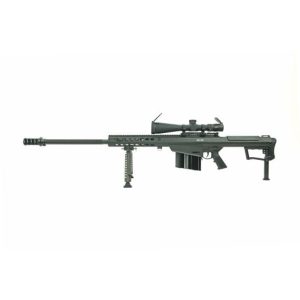
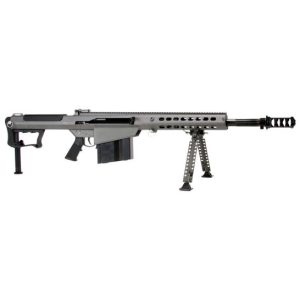
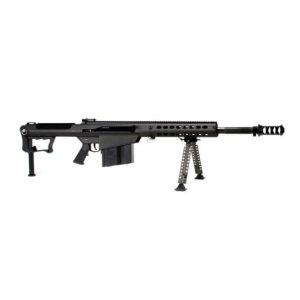
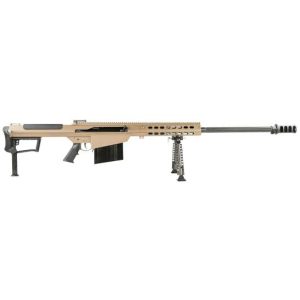
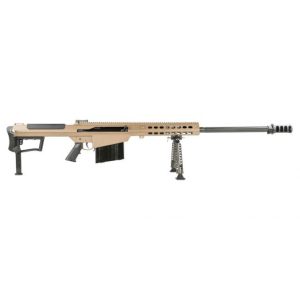
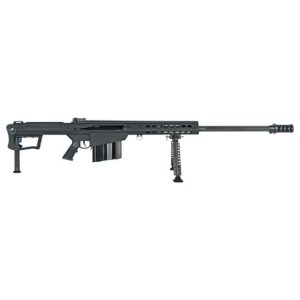
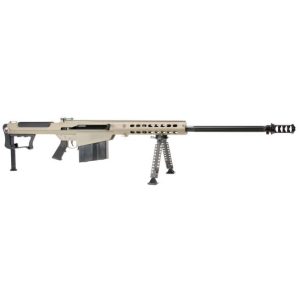
Reviews
There are no reviews yet.